Saturday mornings adventure, I eagerly ventured to the picturesque Birling Gap, nestled along the stunning Beachy Head coastline East sussex UK. Armed with 3 pinhole cameras, my mission was clear: capture the beauty of lensless seascapes and make an informative video for my YouTube Channel.
Nature seemed to conspire in my favor as I reached the location, greeted by a mesmerizing low tide that unveiled a rugged and captivating rocky seashore. The stage was set, and everything appeared to align seamlessly, or so I thought.
In my camera bag were two large format pinhole cameras - The Zero Image and Mia - and a selection of film holders loaded with Fomapan 100. I also had my trusty medium format Holga WPC (Wide Pinhole Camera), loaded with Ilford Delta 100.
Little did I know, my venture into capturing lensless seascapes at Birling Gap would prove more challenging than anticipated. Out of 12 meticulously framed shots and a pair of soaking wet feet, only 4 photo stood the test. The journey, spanning 3 hours of shooting and filming, followed by at least an extra 2 hours video editing, before delving into the film development process could be complete waste of time.
Loading large format sheet film onto the holder has always been a smooth process for me, and 120 film rarely presents any issues—until it does. Anyone who has grappled with the frustration of film snagging onto the film loading spool inside a changing bag can relate to the unexpected challenges that arise. The confined space becomes hot and sticky, and as the hands get sweaty, the film tends to rebel—curling back, sticking to itself as you try and adjust the film spool, and causing a cascade of complications.
In one such instance, after what felt like an eternity of wrestling with the unruly film, I finally managed to introduce a spare film spool into the bag and load it without further incident. However, a nagging sense of foreboding lingered. The initial struggle inside the changing bag served as a foreshadowing of the hurdles that awaited in the film development process.
After discovering that most of the images from the Holga were ruined and encountering issues with the large format camera (as detailed below), I made the tough decision to abandon the video project and discard much of the footage. However, I'm determined to salvage what I can and will likely create a few shorts with the remaining images. Despite the setbacks, I'm eager to return to Birling Gap for another attempt at capturing successful lensless seascapes soon.
To start with the good photo, 4 images from my large format pinhole cameras
Note: the exposure times on the Mia are much longer, I recently changes the pinhole over due to a small hair like thing going over the images and had had enough of removing it in post. The pinhole size was 0.2 which gave an f-stop of f175, I change it over with another pinhole which was 0.15 which now gives me an f-stop of f233
I had taken 6 images with, but what happened to the other 2??
Out of the developing tank, I pulled out these 2 sheets of film, one being completely overexposed (left), the other, not exposed at all (right).
This at first caused a lot of confusion, I was checking my pinhole was not blocked, checking my exposure times and light meter settings, I eventually figured it out and looking back at video footage confirmed I was right and had made a stupid mistake
Can you see what happend?






.jpg)
.jpg)
.jpg)

.jpg)
.jpg)
Comments
Post a Comment